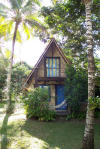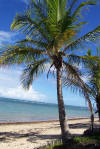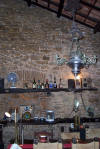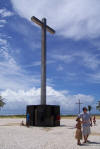Diary/Photo Journal
Week of March 19, 2006
The flight into Porto Seguro was not as awe inspiring as flying into Salvador because we flew above a thick cloud layer. However, in a matter of seconds, we dropped below the clouds and Voila!, there was a beautiful landscape awaiting our appreciation.
We again hit the ground driving and made our way to a nice
Pousada just north of town. Quickly dumping our bags, we turned around and
headed back into town and specifically to the Passarela do Alcool (Alcohol
Walkway - gee, I wonder what brings people to this area?). The pedestrian
area is a kilometers long walkway of restaurants, shops, kiosks and just a "few"
alcohol booths.
From the plain to the garish, the booth's owners decorate their spaces with
flowers and fruits in order to attract the customer. Each serves a variety
of colorful and tasty drinks from the standard pina colada to a Bahia drink
called Capeta (guarana, cocoa powder, cinnamon, sweetened condensed milk and
vodka). With capetas in hand, we were ready to walk the walk and
shop the shop (well, at least I was ready for the latter).
We poked and prodded around the various kiosks and shops and eventually settled into a little restaurant that was more a few tables set up in the living room of the owner. The 20'x20' restaurant was in the front of a home built in the 18th century and a little peek around the door and you look into the owner's own dining room. Needless to say, the food was as cozy as the room and our little window out onto the Passarela do Alcool enhanced the people watching experience.
Walking off an excellent meal, we indulged in a couple more capetas and dodged a terrific downpour of rain. Fortunately for me, not so fortunate for Gerson, we took shelter under the roof of a quirky jewelry store. Needless to say, I just had to take a look (I mean, I had to kill the time until the rain stopped) and enjoyed watching the moths fly out of Gerson's wallet. Brasil has some of the most unusual and unique natural stone, seed and plant jewelry I have ever seen. Ok, enough with my shopping exploits (we only spent about $25)...
The next day we spent driving north along the coast with the destination of the "discovery of Brasil" as our intended target. I question the use of the word "discovery" because, as I have stated before, how can one "discover" a land that people were already occupying?
History lesson time: In April 1500, Portuguese explorer Pedro Cabral, sailed along the coast of Brasil in search of a "safe port". Upon finding "Porto Seguro", he landed 16km north in a place that is now called Coroa Vermelha. Cabral stayed for less than two weeks and it was almost 50 years later when the Portuguese crown created the first capital city, Salvador da Bahia.
Coroa Vermelha is a small town that has grown around the tourism brought in by the monument to Pedro Cabral and his first landing in Brasil. The local Pataxo (Pah-tash-oh) indigenous peoples run many of the souvenir kiosks that line the entrance to the open monument. Upon reaching the plaza, Gerson was approached by a cheeky boy selling seed necklaces. We saw that his brother (as it turned out) was assembling the trinkets while sitting at the base of the monument and we could not resist spending the $1Real for the attractive necklace.
Of course, the boy did not have change for a $2Real bill and supposedly, nor did his brother. So, we opted to buy two necklaces and asked to take a look at the strands that the brother was making. Upon close inspection, I found a second necklace I liked and with the jostle of the articles, a few of the brother's Reais spilled to the ground. Lo and behold, there were $1 Real coins and $1 Real bills on the ground. So much for the brother not having any change...the little rascals learn at a very early age the art of capitalism with a flare of sneakyism. We laughingly bought both necklaces.
I quickly learned how good of a deal that necklace was as it seemed to ward off approaches by the other children selling seed articles. As soon as I flashed my new bauble, they turned away and I was not bothered again.
We decided to visit a small, local museum and were guided by a little imp called David (Dah-veed). We wheeled and dealed and settled on a fee of $2Reais for David's extensive knowledge and ability to communicate. Well, other than finding out that the indigenous peoples had animals, practiced cannibalism and that his mother could still weave baskets, not much else was forthcoming. The $2Reais was worth the laughs we had all the way back to the car. Even writing this makes me chuckle.
After our educational exploit in Coroa Vermelha, we took a quick ride up north. Santa Cruz Cabralia is another smallish town that espouses the first Portuguese settlement and a small church built by the Jesuits in 1630. Well restored and well kept, it was a pleasant walk around these hundreds of years old buildings.
   |
Igreja NS da Imaculada Conceicao (con-say-shee-oun) built in 1630 It appears
the indigenous peoples |
  |
Our little pousada cabin
Didn't I see this picture in |
As it was getting later in the day, we turned back south and made our way to Arraial d'Ajuda (Ah-high-all d'Ah-jzoo-da - yeah, I had a lot of fun with the name of that town!) and we found yet another fantastic beachfront pousada to spend the next couple of days. We wasted no time dipping into the pool and walking along the beach. A jaunt up into the hippie/touristy town led us to a wonderful restaurant perched on a cliff overlooking the ocean.
We took a side trip to a more southerly town called Trancoso because the further south you travel, the smaller and more quaint the towns. A side trip is an understatement as we turned off the paved highway a bit too soon and found ourselves on a rarely used and even more rarely groomed clay/dirt road. Although scenic, the road was a bit dodgy in more than a few places, but hey, it was a rental car!
Trancoso has a large grassy area called the Quadrado that embraces two of the most important things to Brazilians - their church and their soccer field. We enjoyed the views from atop the cliffs and once we caught a glimpse of a beachfront restaurant, we aimed our rental car downhill.
Just before the beach, we were directed down a road by a smiling boy who promised us restaurants at its end. As we cruised down the street, we noticed the same boy running (in flip-flops) behind us. Once we arrived, he proceeded to tell the "parking lot" attendants (remember how we have to pay for someone to "watch" the car) and then he guided us to "his" restaurant. We did not mind as the waiter that greeted us was yet another big-grinned, happy-to-have-you-there kind of guy and we quickly settled into our table.
We enjoyed not only the food and cold beer beachside, but also our conversation with Amarel, the waiter. Amarel is a Capoeira teacher and his pride was contagious. He and Gerson's conversation (with little interjections by me when I could understand the jest) attracted the other waiters and soon soccer and the various teams were being joked about.
What was really nice was being told to go ahead and enjoy the beach and we could pay the bill later. That way, if we wanted something after we played on the beach, it would just go on the same bill. Of course, we had something more when we came back hours later; however, can you imagine that offer at a beach restaurant in the United States? Never happen...
We walked along the beach and found a beautiful spot where a river, lined with mangroves, emptied into the ocean. Gerson took a swim in the cool, refreshing water and I found solace in looking out over the river's meandering path among the ocean's sand. Like all boys, Gerson sees a stick and wants to throw it in the water with the only problem being, the stick is usually in proportion to the boy. In other words, Gerson sees a big log stuck in the bank of the river and enlists my help to roll it into the river. We do so with little effort and Gerson pushes it out to the current to watch his prize float downstream.
The log eventually gets stuck and Gerson decides that he wants to try to move it again. As Gerson was doing so, a rather inebriated local wants to help and jumps in to start pushing the dead tree. The man starts yelling at Gerson to "Push! Push!" and that he wants to move the log to some unknown location across the river. Gerson starts to oblige until my laughter and his realization that the wavering man was not pushing at all. Gerson ended his enslavement and even a look back at the river 30 minutes later saw the local character still struggling with the log. I do not think we will ever know the why or what.
Having to leave the next day, we went back to
Porto Seguro and reorganized our goods for the flight to Rio de Janeiro where we
will meet old friends we see often and a family member not seen in almost 30
years.
Home Page Brasil-South America Diary Index Previous Diary page BR-SA Diary page 8
































